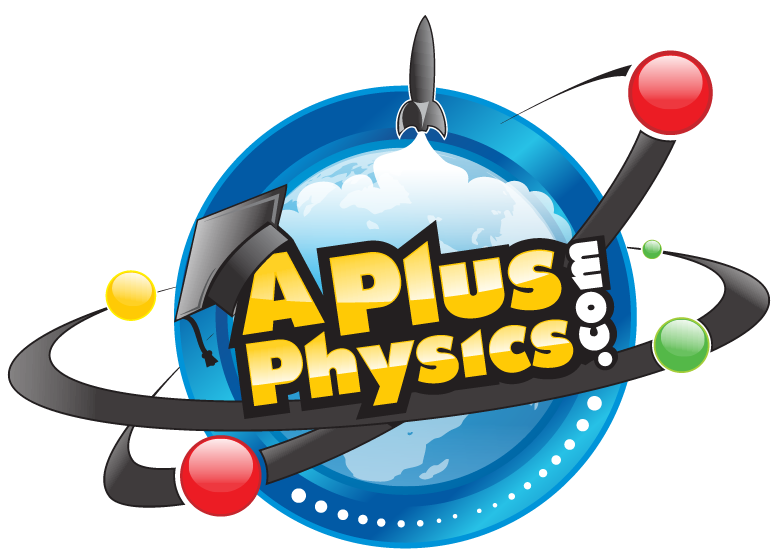Search the Community
Showing results for tags 'Space'.
-
Name: Number of g's or g-Forces Introduction Category: Circular Motion & Gravity Date Added: 2018-01-28 Submitter: Flipping Physics Description and examples of g-forces or number of g’s. Want Lecture Notes? This is an AP Physics 1 topic. Content Times: 0:14 Equations for g-forces or number of g’s 1:08 Number of g’s when at rest on the surface of the Earth 2:43 Number of g’s when in orbit 3:33 Apparent Weightlessness 4:20 How to experience apparent weightlessness in a car 5:22 Apparent weightlessness examples 6:05 Describing number of g’s again 7:08 More examples of number of g’s Next Video: Gravitational Field Introduction Multilingual? Please help translate Flipping Physics videos! Previous Video: Apparent Weightlessness Introduction Please support me on Patreon! Thank you to Sawdog, Christopher Becke, Frank Geshwind and Scott Carter for being my Quality Control Team for this video. Thank you to Youssef Nasr for transcribing the English subtitles of this video. Picture and Video credits: NASA Logo https://www.nasa.gov/sites/default/files/thumbnails/image/nasa-logo-web-rgb.png Liquid Ping Pong in Space - RED 4K https://www.youtube.com/watch?v=TLbhrMCM4_0 Side view of plane in field - https://commons.wikimedia.org/wiki/File:Airplanes_-_Types_-_Kirkham_Triplane_manufactured_by_the_Curtiss_Engineering_Corp.,_Garden_City,_Long_Island._Side_view_of_plane_in_field_-_NARA_-_17341451.jpg Tesla-Roadster-2020-1280-01 - https://www.netcarshow.com/tesla/2020-roadster/1280x960/wallpaper_01.htm STS120LaunchHiRes-edit1 - https://commons.wikimedia.org/wiki/File:STS120LaunchHiRes-edit1.jpg Soyuz_TMA-13_Edit - https://commons.wikimedia.org/wiki/File:Soyuz_TMA-13_Edit.jpg Hong Kong skyscrapers in a night of typhoon.jpg - https://upload.wikimedia.org/wikipedia/commons/8/8d/Hong_Kong_skyscrapers_in_a_night_of_typhoon.jpg Number of g's or g-Forces Introduction
-
Name: Apparent Weightlessness Introduction Category: Circular Motion & Gravity Date Added: 2018-01-21 Submitter: Flipping Physics Learn why astronauts in the International Space Station appear to have no weight. Want Lecture Notes? This is an AP Physics 1 topic. Content Times: 0:01 What is necessary for an object to be completely weightless? 2:34 Determining the acceleration due to gravity on the International Space Station 3:41 Why astronauts appear to be weightless 4:55 Why the International Space Station does not fall to the Earth 5:37 Objects in orbit experience apparent weightlessness 5:56 Other examples of apparent weightlessness Next Video: Number of g's or g-Forces Introduction Multilingual? Please help translate Flipping Physics videos! Previous Video: Dropping a Bucket of Water - Demonstration Please support me on Patreon! Thank you to Jonathan Everett, Sawdog, Christopher Becke, Frank Geshwind, and Scott Carter for being my Quality Control Team for this video. Thank you to Youssef Nasr for transcribing the English subtitles of this video. Apparent Weightlessness Introduction
-
- space
- weightlessness
- (and 5 more)
-
Name: Newton's Laws of Motion in Space: Force, Mass, and Acceleration Category: Dynamics Date Added: 2015-10-07 Submitter: FizziksGuy Uploaded on Apr 18, 2010ESA Science - Newton In Space (Part 2): Newton's Second Law of Motion - Force, Mass And Acceleration. Newton's laws of motion are three physical laws that form the basis for classical mechanics. They have been expressed in several different ways over nearly three centuries. --- Please subscribe to Science & Reason: • http://www.youtube.com/Best0fScience • http://www.youtube.com/ScienceMagazine • http://www.youtube.com/FFreeThinker --- The laws describe the relationship between the forces acting on a body and the motion of that body. They were first compiled by Sir Isaac Newton in his work "Philosophiæ Naturalis Principia Mathematica", first published on July 5, 1687. Newton used them to explain and investigate the motion of many physical objects and systems. For example, in the third volume of the text, Newton showed that these laws of motion, combined with his law of universal gravitation, explained Kepler's laws of planetary motion. --- Newton's Second Law of Motion: A body will accelerate with acceleration proportional to the force and inversely proportional to the mass. Observed from an inertial reference frame, the net force on a particle is equal to the time rate of change of its linear momentum: F = d(mv)/dt. Since by definition the mass of a particle is constant, this law is often stated as, "Force equals mass times acceleration (F = ma): the net force on an object is equal to the mass of the object multiplied by its acceleration." History of the second law Newton's Latin wording for the second law is: "Lex II: Mutationem motus proportionalem esse vi motrici impressae, et fieri secundum lineam rectam qua vis illa imprimitur." This was translated quite closely in Motte's 1729 translation as: "LAW II: The alteration of motion is ever proportional to the motive force impress'd; and is made in the direction of the right line in which that force is impress'd." According to modern ideas of how Newton was using his terminology, this is understood, in modern terms, as an equivalent of: "The change of momentum of a body is proportional to the impulse impressed on the body, and happens along the straight line on which that impulse is impressed." Motte's 1729 translation of Newton's Latin continued with Newton's commentary on the second law of motion, reading: "If a force generates a motion, a double force will generate double the motion, a triple force triple the motion, whether that force be impressed altogether and at once, or gradually and successively. And this motion (being always directed the same way with the generating force), if the body moved before, is added to or subtracted from the former motion, according as they directly conspire with or are directly contrary to each other; or obliquely joined, when they are oblique, so as to produce a new motion compounded from the determination of both." The sense or senses in which Newton used his terminology, and how he understood the second law and intended it to be understood, have been extensively discussed by historians of science, along with the relations between Newton's formulation and modern formulations. Newton's Laws of Motion in Space: Force, Mass, and Acceleration
-

The Workings of Reflecting Telescopes
running_dry posted a blog entry in Tired and a little dehydrated
The second major type of telescope is the reflecting telescope. The reflecting telescope was invented by Newton and considered an improvement on Galileo's design. Most reflecting scopes still use Newton's design. Reflecting scopes use a wide concave mirror at the back of the tube to bring light to a focal point in front of the mirror which is then usually reflected sideways toward the eyepiece by a flat, angled mirror. There are also compound scopes that work like reflecting scopes but there is a hole in the center of the concave mirror and the mirror at the foal point reflects light back through the hole where it is magnified by an eyepiece at the end of the tube. Below are diagrams of both reflecting and compound telescopes. Now for some pros and cons. Refractor tubes are usually longer and skinnier, thus have smaller apertures (and cost more per unit of aperture length); while reflectors are wider and shorter with larger apertures (and less cost per unit of aperture length). Because of this, refractors are usually more expensive and better for observing close planets while reflectors are better for observing deep sky objects like galaxies and nebulae. -
Last night I happened to look up as I was walking inside at around 10 and noticed that I could see a lot of stars. Like a lot. I am quite a fan of stargazing but despite owning a telescope I have always done it with my naked eyes. But I was in the mood to see some planets in detail so I lugged down the old telescope from the attic and dusted her off only to make a distressing discovery- all the eyepieces were missing (you need those if you want to see anything). My dad and I scoured the dust and cobweb infested boxes in our attic for half an hour but came up empty handed, and I had to resign to reading a book. Now that you have gotten through my exceptionally boring story, I would like to tell you how telescopes work. The basic function of a telescope is to collect, focus and magnify the light emitted from celestial bodies (stars, planets, nebulae, galaxies, ect...). In many cases, it is actually more important to collect and filter light than it is to magnify it. The ability of a telescope to collect light is related to it's aperture- which is it's lens or mirror diameter- and it's ability to magnify depends on magnification. Aperture is usually harder to expand as it depends on the diameter of the telescope tube but magnification can be changed as easily as screwing in a new eyepiece. The first telescope created by Galileo was a refracting telescope. Contrary to popular belief, Galileo did not invent this technology but he was the first to apply it to the art of stargazing. Refracting scopes use a large objective lens at the front of the tube to collect and bring light into a focal point in the middle of the tube. From there it can be focused and magnified by the eyepiece. Below is a diagram of how light travels through refracting lenses. Check out my next post for reflecting telescopes and closing thoughts.
-
This March, the F-35 Lightning II made its first public demonstration at an air show. The U.S. Military is expected to purchase over a thousand of the new jets in total, eventually being put in service with the Navy, Air Force, and Marine Corps. The Air Force version, the F-35A, will be the lightest and most agile. The thrust to weight ratio is over one, meaning that the engine produces more thrust (191 kN!) than the weight of the aircraft. In other words, it is able to speed up while flying 90 degrees to the ground...straight up. The Marine Corps version, the F-35B, is the most powerful, in that it has a specialized engine. The thrust can be vectored down to "push" the aircraft off the ground, therefore allowing the aircraft to take off in ridiculously short distances (perfect for the Marines' shortened aircraft carriers) Lastly, the Naval version, the F-35C, has a larger wing area and strengthened landing gear for landing on an aircraft carrier. The wing area is increased simply because this version will have to fly very slow on final, meaning more lift is needed to keep the aircraft from entering an aerodynamic stall. The increased wing area provides more lifting surface area, so (by Bernoulli's principle), more air will flow over the airfoil, inducing a greater low pressure area over the wing. More lift is then created, allowing this model to control itself as very low airspeeds.
-
Escape Velocity and its Applications
pavelow posted a blog entry in Blog Having Nothing to do with Physics
The calculation for escape velocity is a pretty simple conservation of energy problem. K at infinity =.5mv2 = 0 because v at infinity = 0 U at infinity = GMm/r = 0 at infinity because r = infinity K=0 U=0 K=U .5mv2 = GMm/r From there it's simple algebra, and escape velocity is ve = sqrt(2GM/r) This equation's applications are seen in the exploration of space. Spacecraft need to reach escape velocity in order to not eventually crash back into the earth's surface. Some satellites are orbiting earth at just above escape velocity, meaning that they are actually spiraling away from the planet. On the other hand, some satellites are orbiting just below escape velocity, meaning that they will eventually fall into the atmosphere and burn up. However, some of these satellites have on-board rockets which can change their trajectory, allowing for more stable orbits and longer lifetimes. The Voyager 1 spacecraft used its escape velocity to leave the solar system and explore what lies beyond. NASA's Curiosity mission required the spacecraft to reach near escape velocity (although I'm sure the actual spacecraft reached a higher speed) to make it to Mars. As humans explore more of the space that surrounds the planet, escape velocity and its applications will become even more important. -
Below the atmosphere, we have a little problem called global warming, or just in general high levels of pollution for you non-believers, which is the general degradation of our atmosphere and lakes and oceans due to excessive amounts of waste, brought on by agregious practices and poor waste management. In space, there's Kessler syndrome, the hypothetical scenario where, when the amount of space debris orbiting our planet becomes over-saturated, various "leftovers" from spacecraft will collide and split apart, going on to hit even more debris creating a cascade of small but dangerous shrapnel that will make travelling through low-earth orbit an unfeasible, and at the very least highly difficult, affair. Just like below our atmosphere's limits, we need to be concerned about pollution. While space pollution has a much smaller influence (space is big, and the chances of hitting something are slim), it is still dangerous and costly, but much of the time preventing this pollution is difficult, as it requires a lot of energy to bring a empty fuel tank or decoupler back down into the atmosphere. But, for the moment, it isn't too serious, so in case any of you were actually planning a mission into the grasps of space, don't get anxious.
-
The second-largest moon in our solar system, Titan, orbits around Saturn, about 8.5 AU (the distance from Earth to the Sun) away from us, making it a very chilly place. A fairly massive moon (80% more massive than our moon, according to Wikipedia), it has the unique characteristic of having an atmosphere that obscured views of the surface until the launch of the Cassini-Huygens mission in 2004, designed to chart out primarily the Saturn system. A moon with an atmosphere is strange, and interesting. But what makes Titan truly intriguing is the presence of a liquid cycle, akin to our water cycle, in it's atmosphere and on it's surface. An average temperature of -179.5 degrees Celsius means that this liquid isn't water - it's methane. The atmosphere and oceans of Titan are composed of liquid methane, which, under the conditions on the surface, acts similarly to water. It evaporates, precipitates, and forms liquid bodies and oceans, just like on Earth. Deeper down below the surface, there is, in fact, liquid water too, at higher temperatures and pressures beneath an icy "crust". Titan is a strange planet, but interesting in it's composition. With a thicker, denser, and "taller" atmosphere than our own, it has some unique properties, and manages to be Earth-like in strange ways, by substituting life-giving water with a whole lot of poisonous (to us) hydrocarbons. But it is interesting nonetheless.
-
A lot of games let you fly planes, but when was the last time one let you fly a rocket? While if that has been what you've been looking for in your time-wasting pursuits, wait no longer, for Kerbal Space Program lets you do just that. As the director/god of the aptly named Kerbal Space Program, you have the ability to launch probes, satellites, landers, space planes, and a whole plethora of fancy little stuff. But behind all of this glamour comes (simplified) rocket science. Much like real rocket scientists, you have to design a craft with fuel and power constraints in mind. Going to the Mun may not be as trivial a task as some may hope. If you prefer fast paced action, this game probably isn't for you. But if you're willing to think a bit, ponder questions about choosing an engine with a larger thrust to weight ratio versus one with a higher specific impulse, or how you should stage your creation to successfully land on Minmus and return home safely, this might just be your cup of tea. I recommend checking it out.
-
Here's something I just stumbled upon a few minutes ago. Its Olympus Mons, Mars' largest mountain. Olympus Mons is also the largest volcano in the solar system and the 2nd tallest mountain in the solar system (behind the Rheasilvia peak on the asteroid 4 Vesta). Olympus Mons is a shield volcano and was formed the same way that the Hawaiian islands were, by lava flows hardening and building up over hundreds of millions of years. The difference is that while the Hawaiian chain was formed by Earths crust moving over a hot spot in the mantle, Mars does not have mobile tectonic plates so the hotspot that releases lava is always in the center of the mountain. Olympus Mons is located near the martian equator and is 370 miles wide and 13 miles tall, with cliffs up to 5 miles tall. The base covers an area roughly the size of the state of Arizona and is 2.5 times taller than mount Everest. The atmospheric pressure at the highest point is estimated to be 0.03kPa, which is 12% of the average martian atmospheric pressure of .6kPa. What's interesting about this is that the air pressure at the summit of Olympus Mons is a much higher percentage of the surface pressure than it would be on Earth. The atmospheric pressure on Earth at an altitude of 13 miles is approximately 4.5kPa, just 4.43% of the average sea level pressure of 101.33kPa. This happens because the acceleration due to gravity on mars in 3.7m/s2, less than half of that on Earth, which increases the scale height of Mars' atmosphere, so there is relatively higher atmospheric pressure at higher altitudes. It's amazing to think that there are mountains out there on other planets that dwarf anything we have on Earth. I've always been interested in space but my interest just peaked (pun intended) as I look out at the night sky and wonder what else is out there.
-
If a random star were to appear in our skies, and you asked an astronomer how far away it was, they couldn't give you an immediate answer. One thing I always took for granted was how these scientists were able to map the night sky, give us a detailed perspective on what was out there in the final frontier. Some of these methods (like how to determine how far away a star is) can be somewhat interesting. Using the right math, many people could triangulate the position of an object, as long there are a few known variables and objects in the field of view. However, on Earth, to calculate how far away a star is, through distances spanning hundreds of light years, it is very difficult, because the angles which are being dealt with are very small, and hence prone to error. However, given a 6-month span, our orbit around the sun gives us a much better distance to do this calculation with. Knowing such things as the precise time, radius of orbit around the sun, and the positions of other stars in the sky, we can calculate relatively well star distances. However, this only really works up to 400 light years (thanks, HowStuffWorks), because, while the 150 million kilometer difference in our position is a lot, with a star 10 light years away (still fairly close), the difference in angle is still miniscule, clocking in at just a few hundred-thousandths of a degree. Which is to says, that while the distances we get aren't perfectly accurate, for what they're worth they are pretty dang good. There are different, more spectroscopic and more accurate methods of determining a star's distance, that rely on standard gathered data for stars that work at all distances. But before this data was collected, really the only way to gather this data was through triangulation. That, simply put, means that olden astronomers, those like Galileo, were the ones doing all this tricky math. Cool stuff.
-
Escape velocity, at the surface of the earth, is just about a whopping 11.2 km/s. This means that, to completely escape the force of earth's gravity, from the surface of the earth with the only outside for being gravity, you would need to be going this speed to escape (ignoring, of course, drag - drag forces at those speeds would rip a spaceship apart). So on my way to physics last friday I thought about how to reach those speeds, without the use of costly rocket fuel. One (although initially very costly solution) could be to have a giant underground tunnel, throughout the entire surface of the earth, that would accelerate an object over time using electromagnetism until it reaches those speeds. As long as the tube is in a vacuum, it is more than possible to do this. In order to keep an object in a circular orbit, we know that the centripetal acceleration must equal mv^2/r, and this net acceleration can only come from two other sources - gravity, at a constant 9.81 m/s^2, and the force generated by our electromagnetic coils. Assuming v is terminal velocity, E is the electromagnetic force, and r is approximately the radius of the earth, we get (11.2 * 10^3 m/s)^2/(6.371 * 10^6) = 9.81 + E. Solving for this, we can determine that E = 9.88 m/s^2, only a bit more than the acceleration due to gravity. If you could somehow construct this tunnel, it would be possible to bring objects up to speeds as high as this. Most of the time, for typical space missions, it wouldn't have to be quite so large anyways. The real issue is getting in out of the tunnel, and through the atmosphere. Going straight into the air at such speeds would destroy a fair chunk of the surrounding area, and most certainly the payload. You would have to create a giant vacuum tunnel through the atmosphere if you wanted this to work, which not only would look strange (it would be technically 'flat' - tangential to the point of release for the most part), but be very difficult to build. But in any case, it's wishful thinking.
-
What I've learned from kerbal space program. TOP 5
caffeinefueledphysics posted a blog entry in Blog caffeinefueledphysics
Okay, so for the last few months in physics we've worked on the kerbal space program, and although my group didn't really accomplish much, i kinda just wanted to finalize a few things that i learned. So there is my top 5 1) Kerbals are easily startled. meaning, these kerbals are astronauts that should have been previously trained and have experienced the forces existing in a spacecraft or spaceplane in the game. clearly this was bypassed as much as the safety measures on my rockets 2) Orbit CAN be achieved, around anything. if you think that you will randomly drift out to space when you launch a rocket, that turned out to be a rare occurrence for me. I often would randomly test out a rocket to see if it was too heavy or light to do anything, and it would drift off, past orbit, and then into orbit of the sun, right near kerbin. 3)Air intake does not work in a vaccuum. and for those of you that think its a no brainer, i went into this with no previous rocket science training besides the universal F=ma and g=9.81m/s2 Therefore, i had no idea that on the alpha version of a game that they could differentiate atmospheres from space, but CLEARLY by the plummeting altitude and increasing velocity of my ship, that would be a 'NO' 4) Kerbal's Mun is really hard to get to if you have no idea what you're doing, but look up a single video and orbit 'slingshots' make a heck of a lot more sense. 5)if all else fails, every physics class can be the fourth of july (with satellites, not kerbals PLEASE)
Terms of Use
The pages of APlusPhysics.com, Physics in Action podcasts, and other online media at this site are made available as a service to physics students, instructors, and others. Their use is encouraged and is free of charge. Teachers who wish to use materials either in a classroom demonstration format or as part of an interactive activity/lesson are granted permission (and encouraged) to do so. Linking to information on this site is allowed and encouraged, but content from APlusPhysics may not be made available elsewhere on the Internet without the author's written permission.
Copyright Notice
APlusPhysics.com, Silly Beagle Productions and Physics In Action materials are copyright protected and the author restricts their use to online usage through a live internet connection. Any downloading of files to other storage devices (hard drives, web servers, school servers, CDs, etc.) with the exception of Physics In Action podcast episodes is prohibited. The use of images, text and animations in other projects (including non-profit endeavors) is also prohibited. Requests for permission to use such material on other projects may be submitted in writing to info@aplusphysics.com. Licensing of the content of APlusPhysics.com for other uses may be considered in the future.





